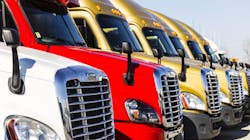Q&A: How to use data analytics, business intelligence in the fleet planning process
It’s that time of year when fleets are going through the planning process for the new year and deciding on just how many new assets they need and which of their existing assets they need to replace.
Whenever I think of asset replacement and asset purchase, I think of data, data analytics and business intelligence tools. Those thoughts take me right to Frank Bussone, vice president of data science & analytics, Corcentric Capital Equipment Solutions. I decided to have a Q&A session with Frank this week to get his thoughts on the use of data in the decision-making process.
Patrick Gaskins: Frank, why can’t fleets just simply replace assets based on time in service and the current odometer reading?
Frank Bussone: Let's start with this fact: making the wrong decision about which asset to replace can cost you thousands of dollars. However, by taking a methodical approach concerning which assets to get rid of, and in what order, will save you money.
PG: What are the key metrics a fleet should consider in replacing assets and what are the other steps in the process?
FB: The first thing you need to do is determine your asset’s life cycle for the newly procured equipment. Remember asset life cycle can vary by location, application and usage and can be affected by current market conditions such as increases or decreases in fuel prices. Your asset’s life cycle will determine the optimal finance structure.
The next step is to rank the operational performance and cost of each asset on an individual basis. An example of variables to include in that ranking are odometer reading, recent utilization, maintenance costs, fuel economy, book value, resale value, etc.
PG: What do you mean by “ranking” operational performance?
FB: You would give the asset with the most miles a ranking of 100 and the one with the fewest miles would be ranked with a 1. You would do this for each variable you selected. Then you would make a composite score for each asset by adding the ranking from each variable and dividing by the number of variables you used. Now you will have asset ranks from high — the worst performing — to low — the best performing.
PG: Okay, now that I have “ranked” all of my assets, what do I do next?
FB: The final step is to conduct a cost analysis on each piece of equipment in which you compare the running cost of that piece of equipment to the running costs of new piece of equipment.
If you are taking on new equipment in Q1 through Q4, this assessment will tell you which assets to get rid of first because they are the ones that are costing you the most money.
These tools measure the performance and operational costs of an asset and doing a running cost analysis really identifies and quantifies when to replace each asset.
You need to rely on data, business intelligence and a set of processes and models in your fleet planning process to help determine the proper replacement of equipment over the next year.
Some fleets have had a tough 2020 because of the impact of business shutdowns on their operations. If business is already down, the last thing you want to do is make the wrong choice on which assets you are getting rid of and when because your costs will go up.
Using data and business intelligence is the best way to ensure you make the best asset purchase and replacement decision each time.
___________________________
Patrick Gaskins, senior vice president of Corcentric Fleet Solutions, oversees both sales and operations for Corcentric’s fleet offerings. Over the past 10 years, Gaskins has grown the fleet services area of Corcentric’s business by implementing a best-in-class asset management database and a data-driven approach to providing Corcentric clients with visibility into all areas of their fleet spend. He joined Corcentric in 2010, bringing over 30 years of experience as a financial services professional in the transportation industry. Gaskins leads a team of industry experts who work with a supply base of over 160 manufacturers to help the country’s largest fleets manage all aspects of their fleet operations and fleet-related spend. Gakins earned his BBA in Finance from the University of Miami, Fla., and his CTP certification from the National Private Truck Council.
About the Author

Patrick Gaskins
Senior vice president, Fleet Solutions
Pat Gaskins is the senior vice president of Corcentric Fleet Solutions, where he leads both the sales and operations teams for the company’s fleet offerings. He has over 30 years of experience as a financial services professional in the transportation industry and manages partnerships with over 160 manufacturers, helping over 2,000 of the country’s largest fleets manage all aspects of their fleet operations and fleet-related spend.
